Abstract
To elucidate the role of inositol 1,4,5-trisphosphate (Ins-P3) in the initiation of agonist-induced contraction of the smooth muscle cells of the dog trachea, we investigated the effects of acetylcholine (ACh) on the concentrations of Ins-P3, phosphatidylinositol-4,5-bisphosphate (PI-P2) or phosphatidic acid (PA). The effects of Ins-P3 on the Ca2+ stored in the smooth muscle cells were also studied in saponin-permeabilized smooth muscle cells. A half maximal or maximal Ca2+ accumulation into the cells was observed in the dispersed single, smooth muscle cells treated by saponin, in free Ca2+ concentrations of 4.6 X 10(-7) or 5 X 10(-5)M, respectively. The ATP-dependent Ca2+ accumulation was maximal at 0.63 nmol/10(5) cells. Effects of Ins-P3 on stored Ca2+ were observed at a free Ca2+ concentration of 3.7 X 10(-7)M, which induces about half maximal ATP-dependent Ca2+-accumulation. Ins-P3 released the Ca2+ accumulated by ATP, in a dose-dependent manner. About 40% of the total Ca2+ was released following application of 3 microM Ins-P3. The release of stored Ca2+ induced by application of Ins-P3 was followed by its re-uptake into the smooth muscle cells. Thus, the stored Ca2+ was repeatedly released with repetitive applications of Ins-P3. Application of ACh (10(-5)M) to the dog trachea stimulated the production of Ins-P3 in the soluble fraction and 10s after this application, the relative amount of Ins-P3 was 290% of the control value.(ABSTRACT TRUNCATED AT 250 WORDS)
Full text
PDF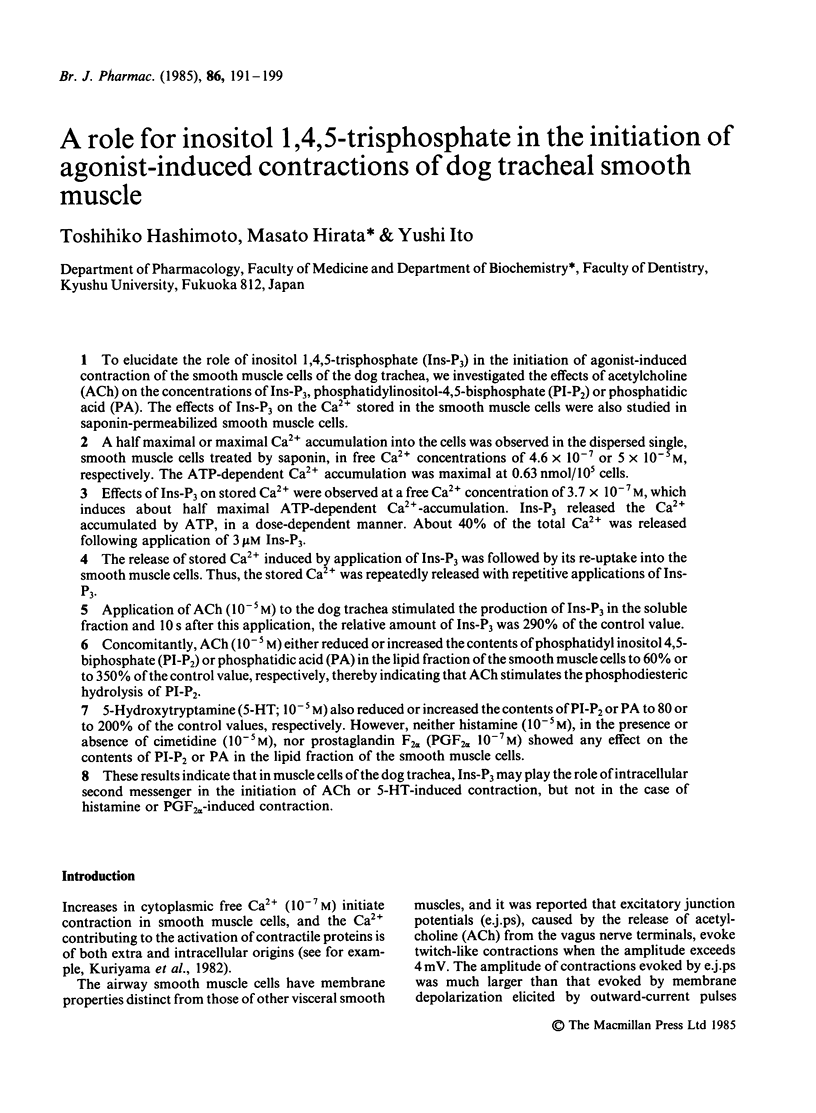
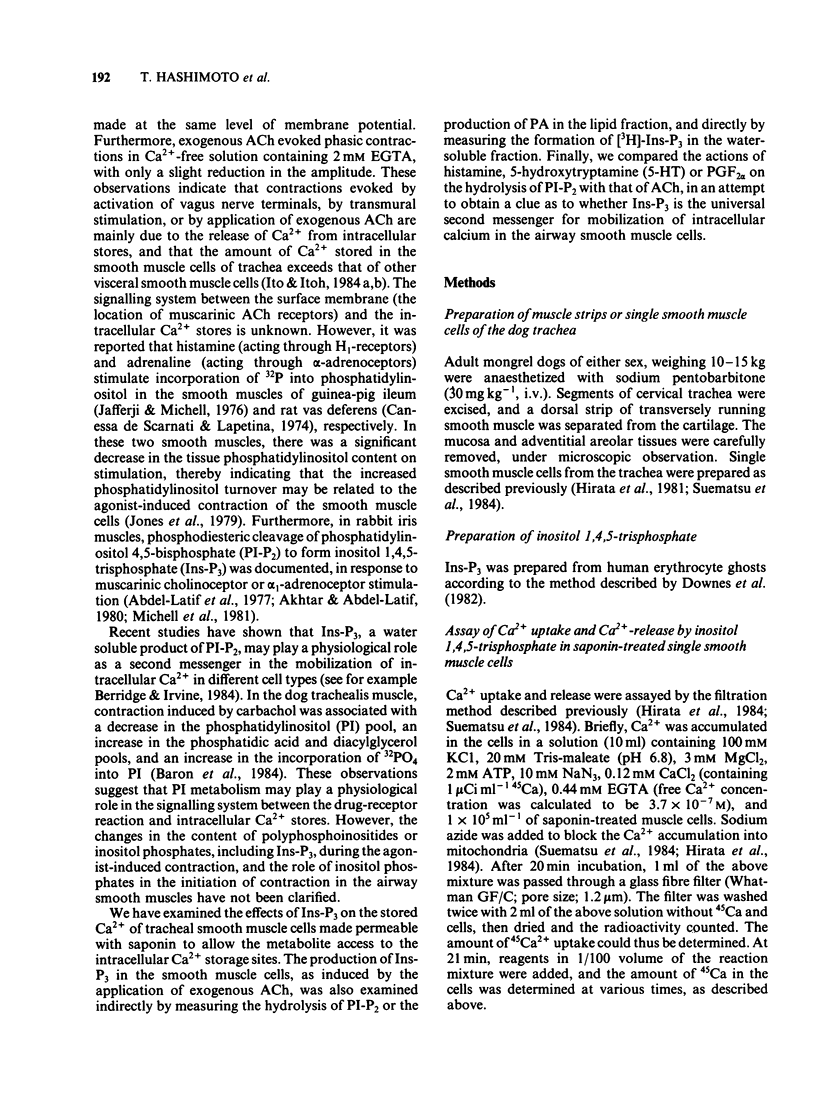
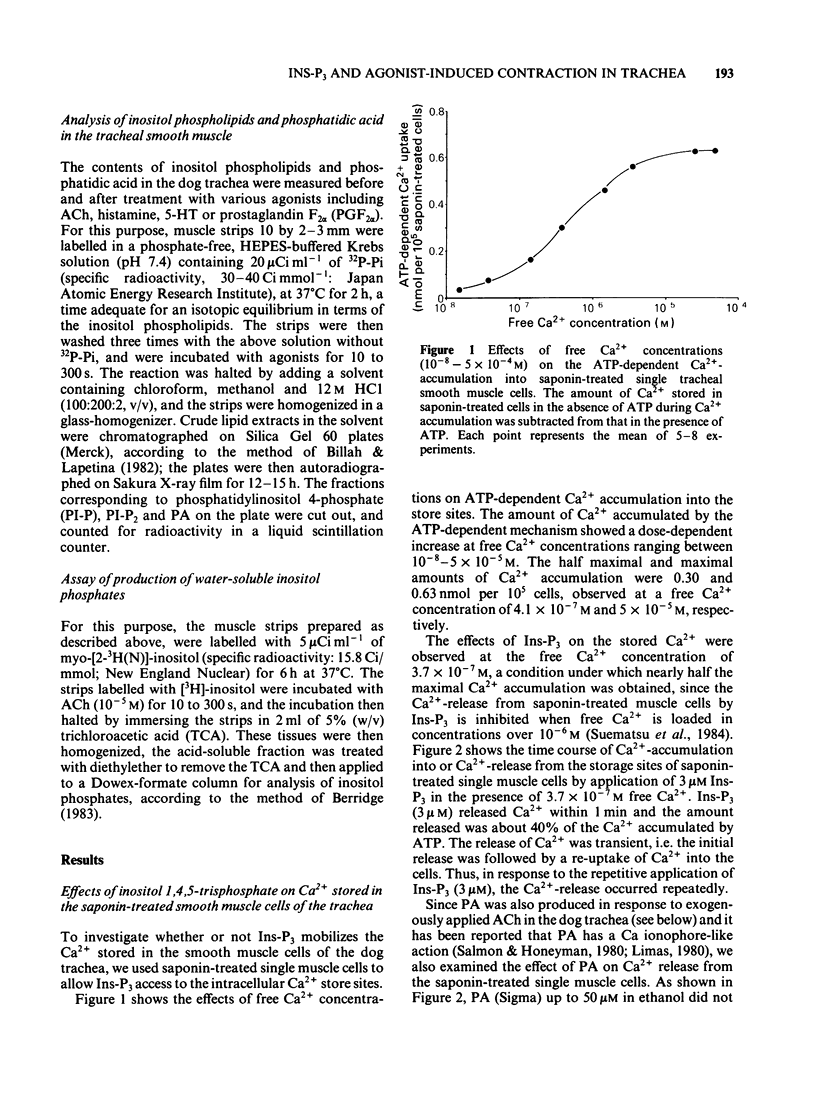
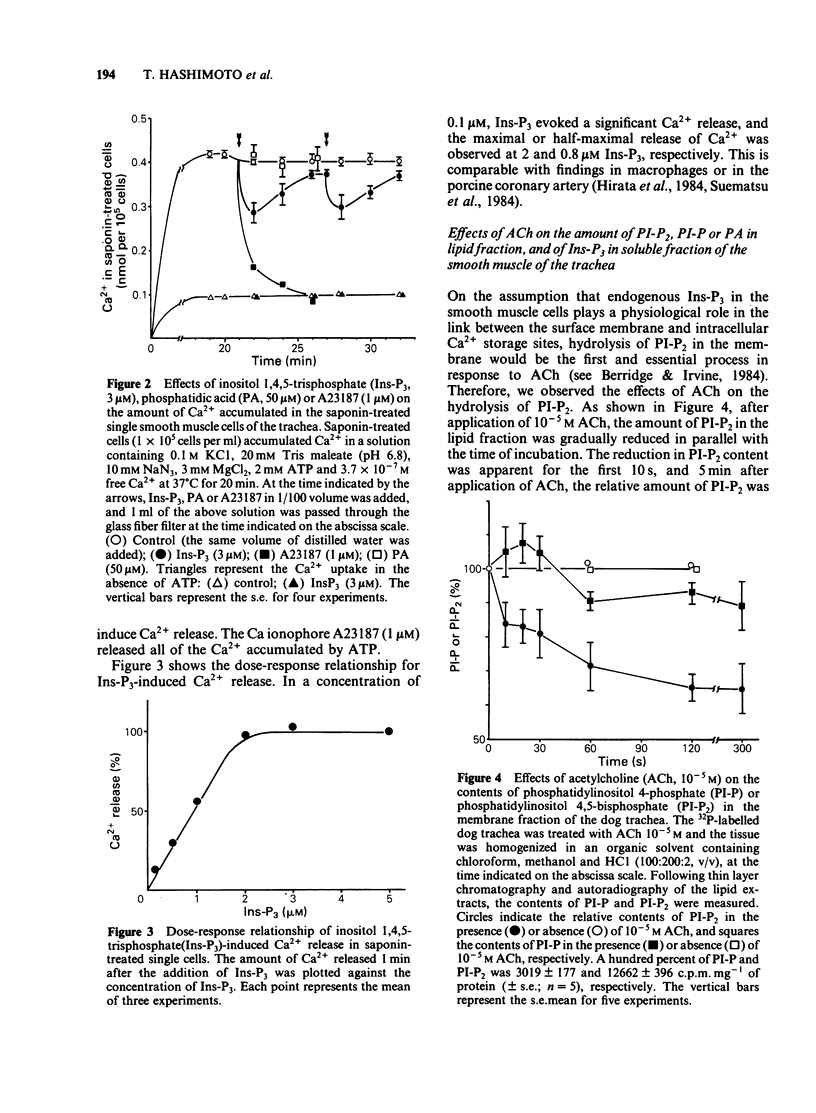
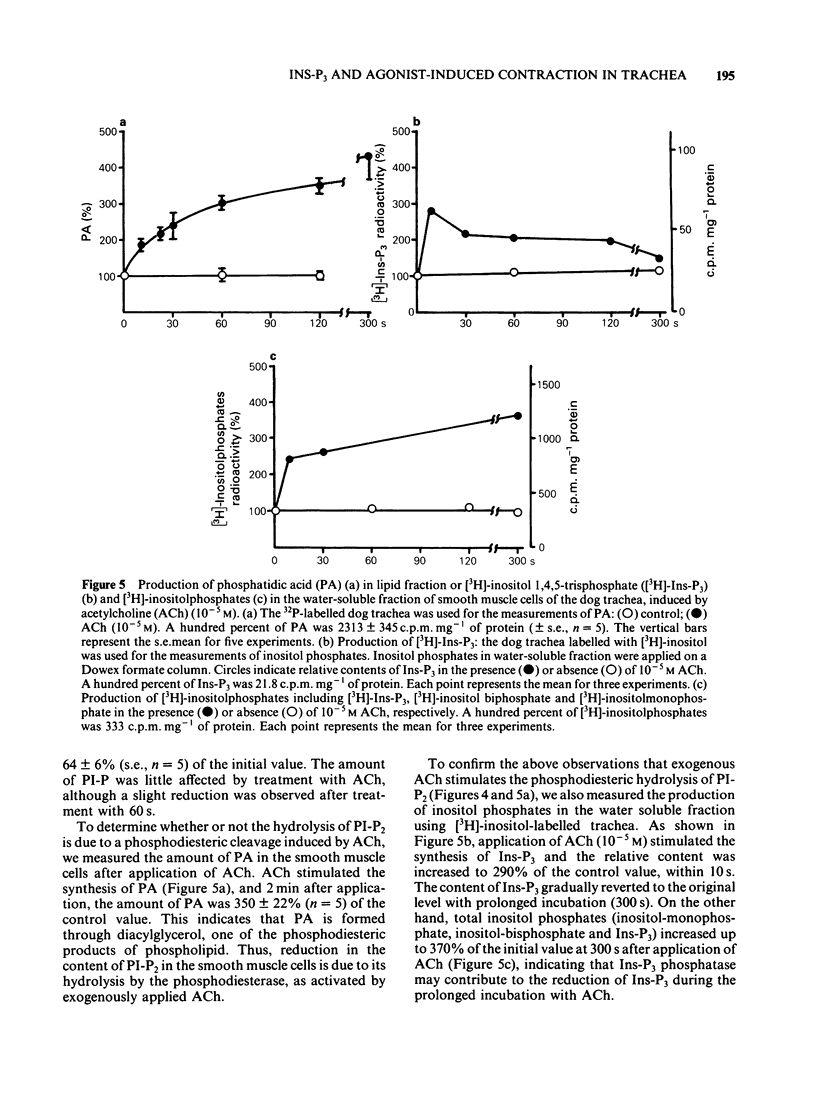
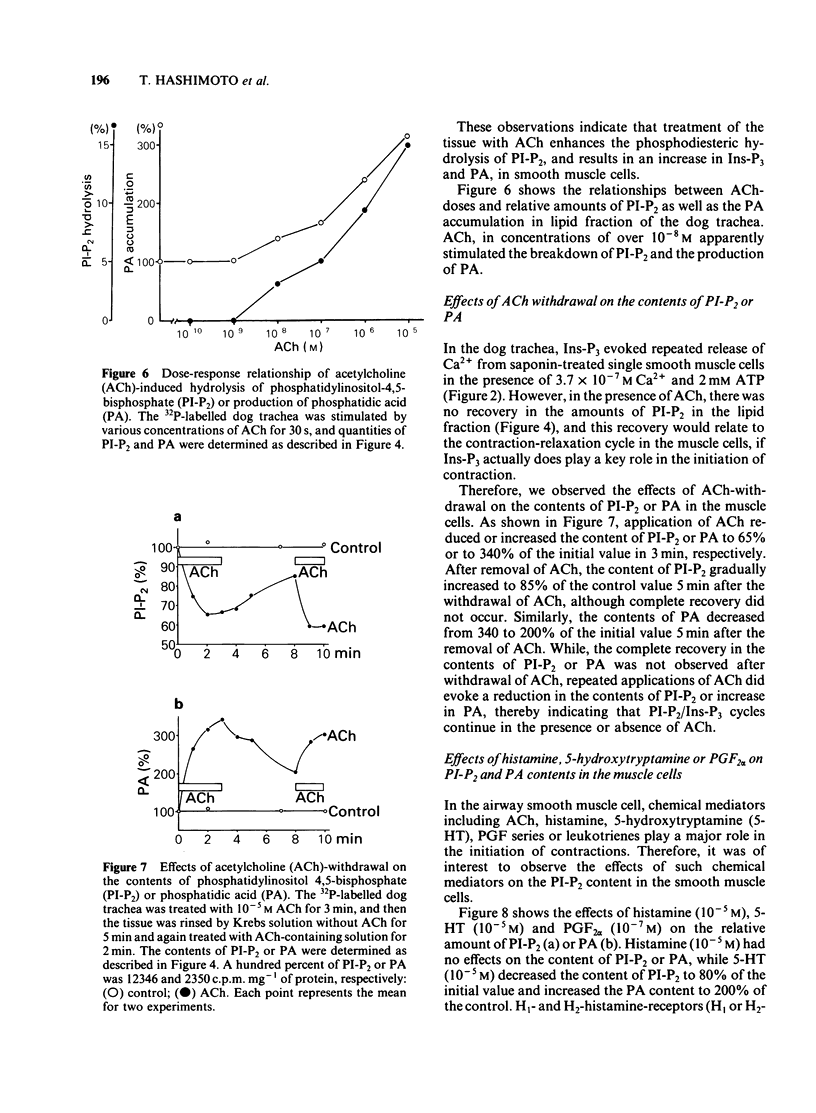
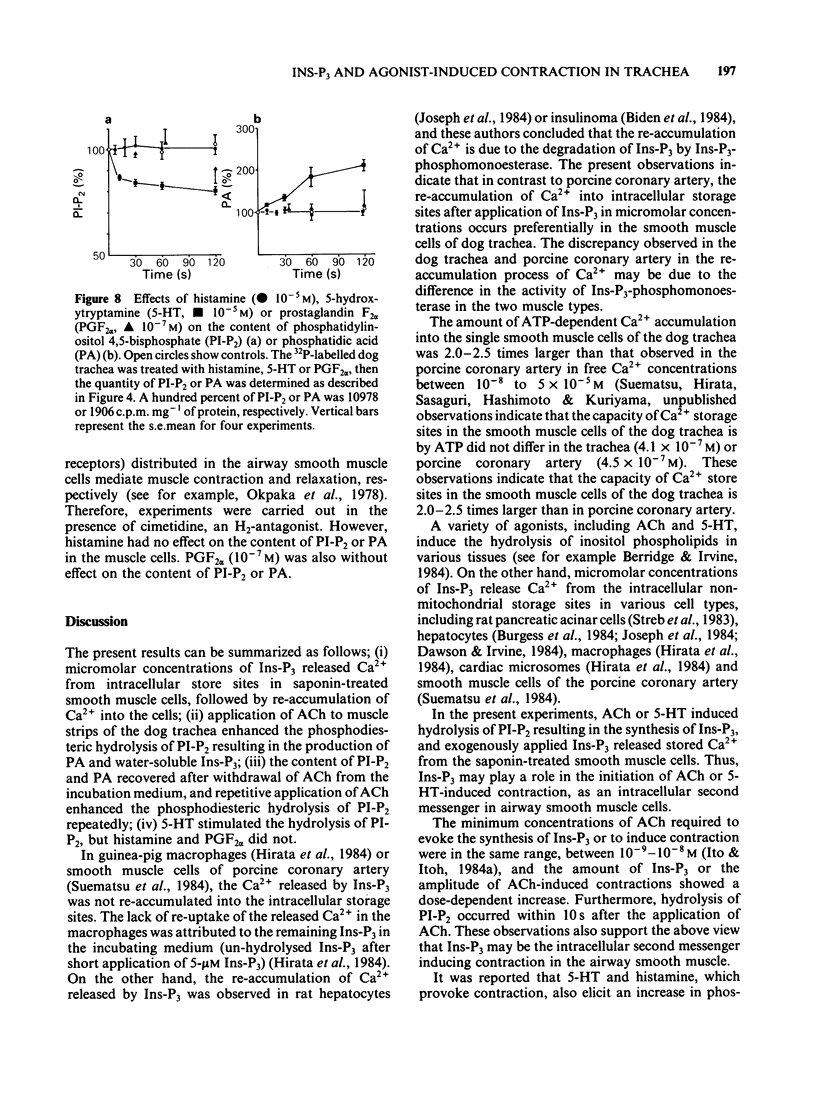
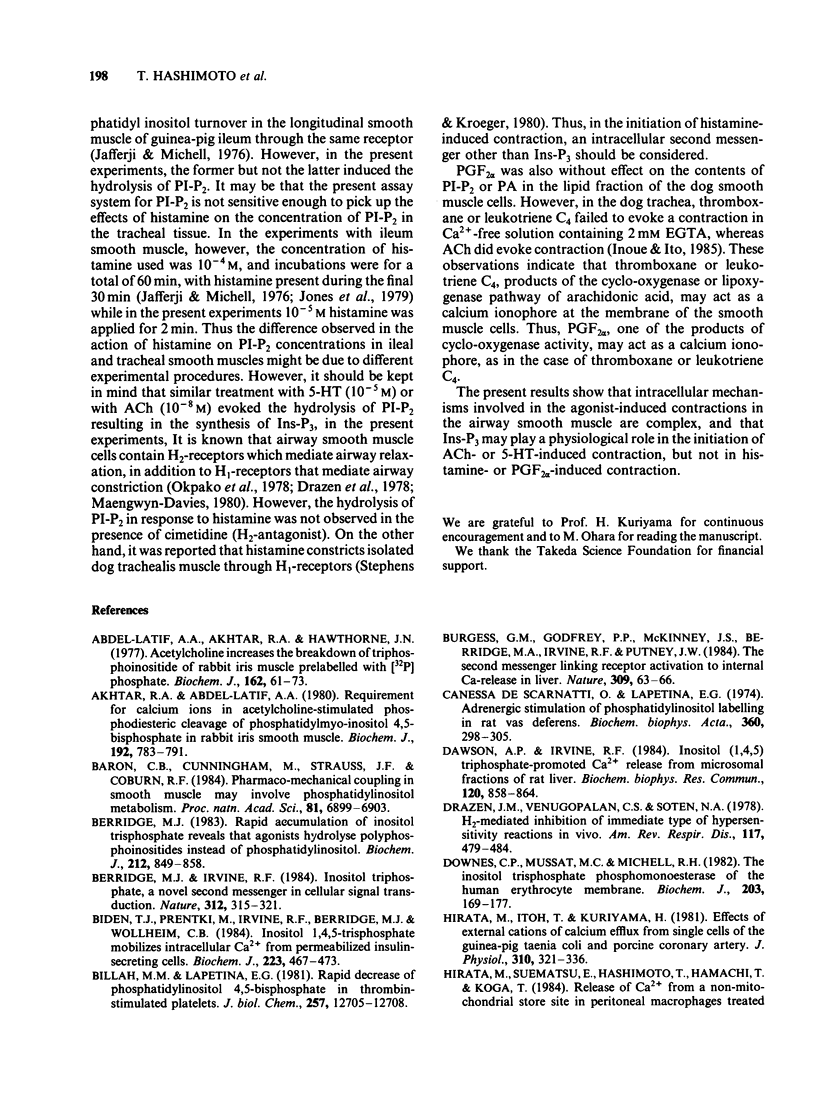
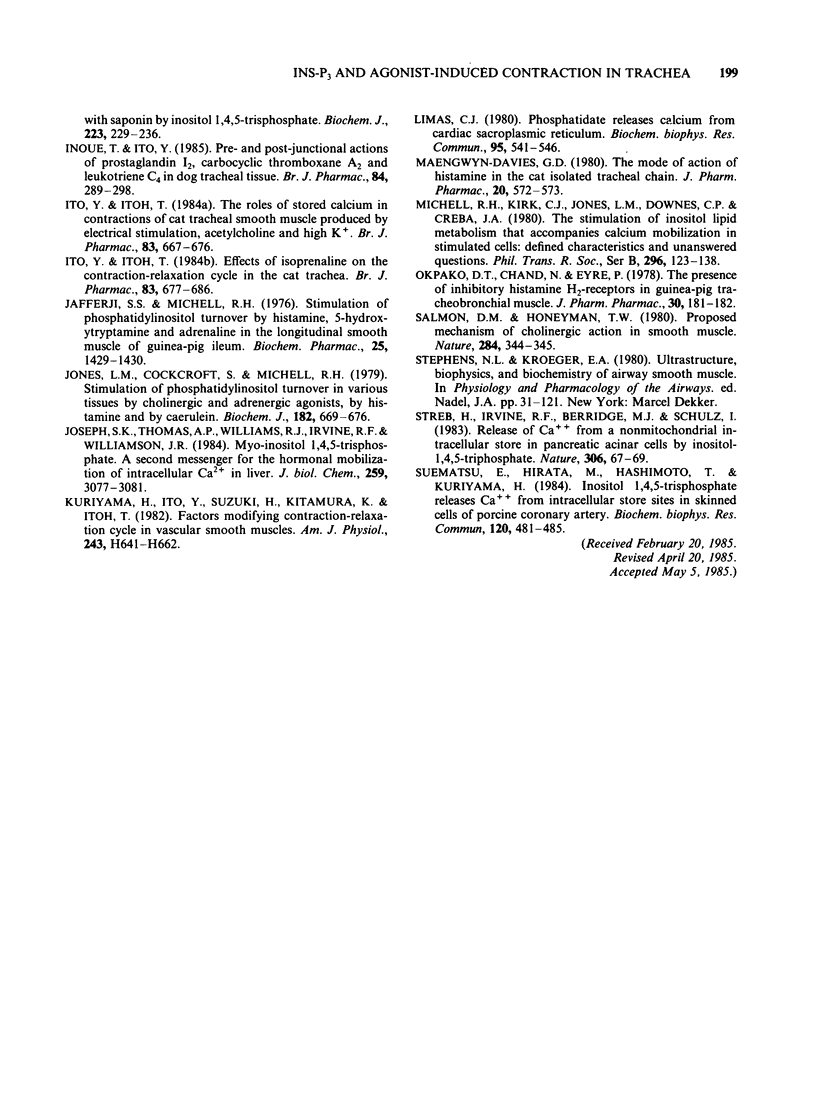
Selected References
These references are in PubMed. This may not be the complete list of references from this article.
- Abdel-Latif A. A., Akhtar R. A., Hawthorne J. N. Acetylcholine increases the breakdown of triphosphoinositide of rabbit iris muscle prelabelled with [32P] phosphate. Biochem J. 1977 Jan 15;162(1):61–73. doi: 10.1042/bj1620061. [DOI] [PMC free article] [PubMed] [Google Scholar]
- Akhtar R. A., Abdel-Latif A. A. Requirement for calcium ions in acetylcholine-stimulated phosphodiesteratic cleavage of phosphatidyl-myo-inositol 4,5-bisphosphate in rabbit iris smooth muscle. Biochem J. 1980 Dec 15;192(3):783–791. doi: 10.1042/bj1920783. [DOI] [PMC free article] [PubMed] [Google Scholar]
- Baron C. B., Cunningham M., Strauss J. F., 3rd, Coburn R. F. Pharmacomechanical coupling in smooth muscle may involve phosphatidylinositol metabolism. Proc Natl Acad Sci U S A. 1984 Nov;81(21):6899–6903. doi: 10.1073/pnas.81.21.6899. [DOI] [PMC free article] [PubMed] [Google Scholar]
- Berridge M. J., Irvine R. F. Inositol trisphosphate, a novel second messenger in cellular signal transduction. Nature. 1984 Nov 22;312(5992):315–321. doi: 10.1038/312315a0. [DOI] [PubMed] [Google Scholar]
- Berridge M. J. Rapid accumulation of inositol trisphosphate reveals that agonists hydrolyse polyphosphoinositides instead of phosphatidylinositol. Biochem J. 1983 Jun 15;212(3):849–858. doi: 10.1042/bj2120849. [DOI] [PMC free article] [PubMed] [Google Scholar]
- Biden T. J., Prentki M., Irvine R. F., Berridge M. J., Wollheim C. B. Inositol 1,4,5-trisphosphate mobilizes intracellular Ca2+ from permeabilized insulin-secreting cells. Biochem J. 1984 Oct 15;223(2):467–473. doi: 10.1042/bj2230467. [DOI] [PMC free article] [PubMed] [Google Scholar]
- Billah M. M., Lapetina E. G. Rapid decrease of phosphatidylinositol 4,5-bisphosphate in thrombin-stimulated platelets. J Biol Chem. 1982 Nov 10;257(21):12705–12708. [PubMed] [Google Scholar]
- Burgess G. M., Godfrey P. P., McKinney J. S., Berridge M. J., Irvine R. F., Putney J. W., Jr The second messenger linking receptor activation to internal Ca release in liver. Nature. 1984 May 3;309(5963):63–66. doi: 10.1038/309063a0. [DOI] [PubMed] [Google Scholar]
- Canessa de Scarnati O., Lapetina E. G. Adrenergic stimulation of phosphatidylinositol labelling in rat vas deferens. Biochim Biophys Acta. 1974 Sep 19;360(3):298–305. doi: 10.1016/0005-2760(74)90059-9. [DOI] [PubMed] [Google Scholar]
- Dawson A. P., Irvine R. F. Inositol (1,4,5)trisphosphate-promoted Ca2+ release from microsomal fractions of rat liver. Biochem Biophys Res Commun. 1984 May 16;120(3):858–864. doi: 10.1016/s0006-291x(84)80186-2. [DOI] [PubMed] [Google Scholar]
- Downes C. P., Mussat M. C., Michell R. H. The inositol trisphosphate phosphomonoesterase of the human erythrocyte membrane. Biochem J. 1982 Apr 1;203(1):169–177. doi: 10.1042/bj2030169. [DOI] [PMC free article] [PubMed] [Google Scholar]
- Drazen J. M., Venugopalan C. S., Soter N. A. H2 receptor mediated inhibition of immediate type hypersensitivity reactions in vivo. Am Rev Respir Dis. 1978 Mar;117(3):479–484. doi: 10.1164/arrd.1978.117.3.479. [DOI] [PubMed] [Google Scholar]
- Hirata M., Itoh T., Kuriyama H. Effects of external cations on calcium efflux from single cells of the guinea-pig taenia coli and porcine coronary artery. J Physiol. 1981 Jan;310:321–336. doi: 10.1113/jphysiol.1981.sp013552. [DOI] [PMC free article] [PubMed] [Google Scholar]
- Hirata M., Suematsu E., Hashimoto T., Hamachi T., Koga T. Release of Ca2+ from a non-mitochondrial store site in peritoneal macrophages treated with saponin by inositol 1,4,5-trisphosphate. Biochem J. 1984 Oct 1;223(1):229–236. doi: 10.1042/bj2230229. [DOI] [PMC free article] [PubMed] [Google Scholar]
- Inoue T., Ito Y. Pre- and post-junctional actions of prostaglandin I2, carbocyclic thromboxane A2 and leukotriene C4 in dog tracheal tissue. Br J Pharmacol. 1985 Feb;84(2):289–298. doi: 10.1111/j.1476-5381.1985.tb12913.x. [DOI] [PMC free article] [PubMed] [Google Scholar]
- Ito Y., Itoh T. Effects of isoprenaline on the contraction-relaxation cycle in the cat trachea. Br J Pharmacol. 1984 Nov;83(3):677–686. doi: 10.1111/j.1476-5381.1984.tb16221.x. [DOI] [PMC free article] [PubMed] [Google Scholar]
- Ito Y., Itoh T. The roles of stored calcium in contractions of cat tracheal smooth muscle produced by electrical stimulation, acetylcholine and high K+. Br J Pharmacol. 1984 Nov;83(3):667–676. doi: 10.1111/j.1476-5381.1984.tb16220.x. [DOI] [PMC free article] [PubMed] [Google Scholar]
- Jafferji S. S., Michell R. H. Stimulation of phosphatidylinositol turnover by histamine, 5-hydroxytryptamine and adrenaline in the longitudinal smooth muscle of guinea pig ileum. Biochem Pharmacol. 1976 Jun 15;25(12):1429–1430. doi: 10.1016/0006-2952(76)90115-5. [DOI] [PubMed] [Google Scholar]
- Jones L. M., Cockcroft S., Michell R. H. Stimulation of phosphatidylinositol turnover in various tissues by cholinergic and adrenergic agonists, by histamine and by caerulein. Biochem J. 1979 Sep 15;182(3):669–676. doi: 10.1042/bj1820669. [DOI] [PMC free article] [PubMed] [Google Scholar]
- Joseph S. K., Thomas A. P., Williams R. J., Irvine R. F., Williamson J. R. myo-Inositol 1,4,5-trisphosphate. A second messenger for the hormonal mobilization of intracellular Ca2+ in liver. J Biol Chem. 1984 Mar 10;259(5):3077–3081. [PubMed] [Google Scholar]
- Kuriyama H., Ito Y., Suzuki H., Kitamura K., Itoh T. Factors modifying contraction-relaxation cycle in vascular smooth muscles. Am J Physiol. 1982 Nov;243(5):H641–H662. doi: 10.1152/ajpheart.1982.243.5.H641. [DOI] [PubMed] [Google Scholar]
- Limas C. J. Phosphatidate releases calcium from cardiac sarcoplasmic reticulum. Biochem Biophys Res Commun. 1980 Jul 31;95(2):541–546. doi: 10.1016/0006-291x(80)90818-9. [DOI] [PubMed] [Google Scholar]
- Maengwyn-Davies G. D. The dual mode of action of histamine in the cat isolated tracheal chain. J Pharm Pharmacol. 1968 Jul;20(7):572–573. doi: 10.1111/j.2042-7158.1968.tb09810.x. [DOI] [PubMed] [Google Scholar]
- Michell R. H., Kirk C. J., Jones L. M., Downes C. P., Creba J. A. The stimulation of inositol lipid metabolism that accompanies calcium mobilization in stimulated cells: defined characteristics and unanswered questions. Philos Trans R Soc Lond B Biol Sci. 1981 Dec 18;296(1080):123–138. doi: 10.1098/rstb.1981.0177. [DOI] [PubMed] [Google Scholar]
- Okpako D. T., Chand N., Eyre P. The presence of inhibitory histamine H-2-receptors in guinea-pig tracheobronchial muscle. J Pharm Pharmacol. 1978 Mar;30(3):181–182. doi: 10.1111/j.2042-7158.1978.tb13193.x. [DOI] [PubMed] [Google Scholar]
- Salmon D. M., Honeyman T. W. Proposed mechanism of cholinergic action in smooth muscle. Nature. 1980 Mar 27;284(5754):344–345. doi: 10.1038/284344a0. [DOI] [PubMed] [Google Scholar]
- Streb H., Irvine R. F., Berridge M. J., Schulz I. Release of Ca2+ from a nonmitochondrial intracellular store in pancreatic acinar cells by inositol-1,4,5-trisphosphate. Nature. 1983 Nov 3;306(5938):67–69. doi: 10.1038/306067a0. [DOI] [PubMed] [Google Scholar]
- Suematsu E., Hirata M., Hashimoto T., Kuriyama H. Inositol 1,4,5-trisphosphate releases Ca2+ from intracellular store sites in skinned single cells of porcine coronary artery. Biochem Biophys Res Commun. 1984 Apr 30;120(2):481–485. doi: 10.1016/0006-291x(84)91279-8. [DOI] [PubMed] [Google Scholar]


